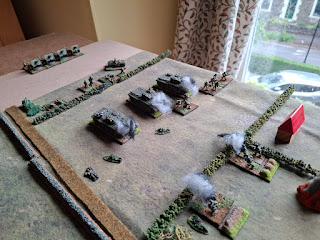I was reminded by a recent post from Heretical Wargaming which set up Lt Turnbulls stand at Neuville-au-Plein on 6th June 1944, about the excellent tactical scenarios provided by 'Fireball Forward'.
I had a brief flurry of enthusiasm for these rules a few years ago as a sort of Squad Leader/Crossfire crossover. Although I lost interest in the rules, the scenarios are very good (many are based on Squad Leader) and are typically pitched a level up from the Skirmish Campaigns scenarios at company+ engagements, so similar to IABSM or whatever. I thought the smaller scenarios would work rather well for WRG games.
Along with the scenarios provided in the FF rulebook, I'd also bought the Villiers Bocage supplement, which covers Operation Perch, 7th Armoured Divisions ill fated attack towards Villiers Bocage in Normandy in July 1944.
Welcome to Livry! This is a tiny 2' x 3' table, oriented pretty much as real life. Left is northwest, right is southeast. For ease I'll just call them west and east. The road to Villiers Bocage runs East-West through the buildings.
The fields are mostly bounded by hedgerows, proper Bocage stuff so they block LOS at ground level, are significant obstacles to movement etc. Although it is hard to make out, the road leading into Livry as far as the crossroads is bounded by a normal hedge on the south side, so concealment for infantry but not an obstacle or LOS block.
There are a couple of small orchards and building clusters. I'm going to use a ground scale of 6" = 100m for this, so the battlefield is about 400m x 600m.
Lurking in the vicinity of Livry are these chaps from the Panzer Lehr Escort Company. Two panzergrenadier sections each with a pair of the rifle/MG42 groups. Each section has a single panzerfaust. There is also a platoon HQ, a Panzerschrek team and as a variable attachment, a tripod MG42 team.
There is a towed Pak 40 with a tracked tow (I'm using a Kettenkrad!) and a "Detachment commander".
Fireball Forward is very big on Squad Leader type section and leader morale ratings, a concept alien to WRG. In the supplied scenario the German infantry are pretty average, but the CO is the best leader as you can get, a proper 'Lt Stahler' (SL fans know who I mean).
So, for this scenario I'm treating the CO as Company Command element, which gives +2 morale to everyone within 200m. I've got a few thoughts about how to deal with elite and green troops too, but that is for future games!
The wicked Germans have ambushed the leading elements of 7th AD and knocked out a Cromwell, leaving a burning wreck on the road. Yes I know it's a Sherman, but I only have three Cromwells.... Anyway, the worried tankers have summoned some infantry to clear the pesky AT gun away.
And here come the Desert Rats. A troop of Cromwells from 8th KRIH and an infantry platoon from The Rifle Brigade. There is also a chap in a jeep with a radio.
Who can call upon these with his radio, a troop of 25pdrs. In the base scenario there is only one fire mission, so in WRG terms I put these guys in 'General Support' which seriously restricts their opportunity to fire on-call fires and also restricts the number of pre-planned fires to three. Hopefully that will avoid unbalancing things too much, and it means we finally get to try out the artillery rules, which are quite detailed. 'Bill' has extensively rewritten the artillery rules and a jolly good read they are too.
This is a tiny game but the British don't have a CC element ( I deliberately didn't give them one as 7th AD were distinctly 'sticky' in Normany), so I wrote a plan instead. My scribbles are reproduced above. I do like a plan, it reminds me playing of Spearhead.
The orders to the tanks and infantry are pretty simple, clear the village and orchards going left flanking. The more complex orders are the artillery ones - for a battery in GS I'm allowed three pre registered targets, so I picked the crossroads and both orchards as suitable terrain features.
I also get to do three pre planned shoots with a GS battery, so I opted for a rolling barrage of three linear concentrations of ground burst HE. There are lots of mission types in the new rules, as well as a nice variety or ammo selections (ground burst, airburst, shrapnel as well as smoke), you can even opt to mix smoke in with the HE barrage to create some obscuration rather than a pure HE barrage.
Anyway, I went with a linear concentration as with a four gun battery it produces a beaten zone 200m wide and 100m deep. As a rolling barrage it advances at 100m per turn, so three rounds of fire starting on turn 2 and centered on that hedgerow northeast of the village should carry my chaps forwards nicely.
After the British wrote their orders, the Germans get to set up. Most of the guys get to set up dug in, but if the AT gun wants to be dug in, it has to set up within LOS of the wreck. I moved the wreck to the crossroads, and dug the gun in 150m down the road. In defilade from the front. but able to cover the fields either side of the Hedgerow. I spent a lot of time on the AT gun placement as it is quite important. The only other sensible spot is the southern Hedgerow, but that is very exposed.
Otherwise I put the two infantry sections dug along the hedgerows on the right, one behind the other and with panzerfaust teams covering the road. The SFMG42 and Panzerschreck team covered the large open field to the left, and also had a partly obscured LOS over the low hedge to the fields in the northwest. The HQ and detachment leader dug in behind the line, and the AT gun tow set up ready to move and hide in the eastern orchard.
These guys were all dug in so unlikely to move, but I always had the option to shift the second section around if needed as the HQ was in close proximity.
The British opening move was uneventful. The tanks and infantry rolled up to the convenient hedgerow, and the tanks sprayed the hedge on the far side of the field with suppressive fire as they moved up. This was ineffective. The Germans lay low.
On turn 2, things began to hot up. The first round of the barrage landed and was quite impressive! Sadly although it looked good, it only managed to suppress one German team. The British infantry hopped over the hedge (which took their whole turn) while the Cromwells continued to rain suppressive HE and MG fire down on the opposite hedgerow.
The combination of the suppressions and obscuration by the barrage made it very hard for the Germans spot anything. So the barrage had actually worked in providing cover for the infantry.
Turn 3 the British line advanced behind the barrage which rolled onto the next German line. This was far more effective and a number of German units were neutralised ( a more serious state than suppression) and one of the buildings was destroyed. I learned a long time ago that unfortified buildings in WRG are a bad place to be. I also discovered on re-reading the rules that along with a beaten zone, artillery barrages have a 'danger zone' around the main beaten zone, which duly spread even more unpleasantness among the defenders.
The Cromwells moved up to support the British infantry who had advanced 100m across the field, but were careful to stay more than 50m from the German trenches. Suppressive fire managed to suppress one of the German teams.
It was now or never and the German opened up. The SFMG42 suppressed one Cromwell, and the Panzerschrek team rolled a mighty 6 and hit another! Sadly it failed to knock it out.
More devastating were the 'suppressed' German infantry, who didn't have any great problems acquiring the British infantry in front of them now the barrage had passed over, and then proceeded to mow down three teams with MG42 fire. The casualties can be seen scattered in front of the Cromwells.
Woops! Perhaps I should have combat moved across the field and then assault moved to within range of the MGs, but I didn't want to lose the barrage.. Oh well, too late now.
Naturally the British infantry rolled a '2' for their reaction test and they promptly halted and went to ground. The Cromwells were unphased however and a rain of HE blew one of the German infantry teams to pieces. The 2" mortar managed to spot the other one and suppressed it. Meanwhile the barrage rolled on, spreading neutralisations left, right and centre and came very close to knocking out the Pak 40! Fortunately for the Germans it was just neutralised, but the church in Livry was demolished by shells.
The surviving German team fired its one and only panzerfaust at one of the Cromwells. It scored a hit but failed to penetrate.
The Panzerschrek team made no mistake however, and got a bead on another Cromwell, hit it and blew it apart. Ouch!
Now it was the turn of the Cromwells to fail their reaction test. "Withdraw from located elements within 200m" . The last German infantry team was still suppressed by the 2" mortar, but they breathed a sigh of relief as the tanks backed up. They didn't realise that the FOO had spotted them and called down a concentration on their position...
Shells rained down on the German positions, neutralising most of the Germans. The stonk however missed the Germans outside the town, and the Panzerschrek rolled another 6 to hit....
And managed to hit and destroy another Cromwell. The tankers morale failed and it was game over at that point. Who needs Pak 40s when you have Panzerschrecks rolling sixes?
And what a scene of devastation was left with shattered buildings, blazing tank wrecks and casualties scattered around the fields and hedgerows.
Iron Cross 1st class for these guys, still holding the line.
That was actually really good fun, and I'm glad I got to try out the artillery even though it is a bit overpowered for a platoon size scenario! In such a small game, luck played a big part, and the ability of the Panzerschrek to throw sixes was uncanny. I should probably have given the British either a command element or a reserve infantry platoon, but hey ho.
I'm not convinced I'm going to play many more of these scenarios using WRG, but doing these tactical games has re-kindled my interest in some smaller scale actions, and I'd like to try out some of the 'forgotten' Fireball Forward scenarios with something a bit easier to manage that uses a grid. Possibly Shaun Travers 'Advancing Companies' or Norm Smiths 'Tigers at Minsk'. In any case, it has been fun trying these old/new rules out and I think I've given them a fair going over.























































































